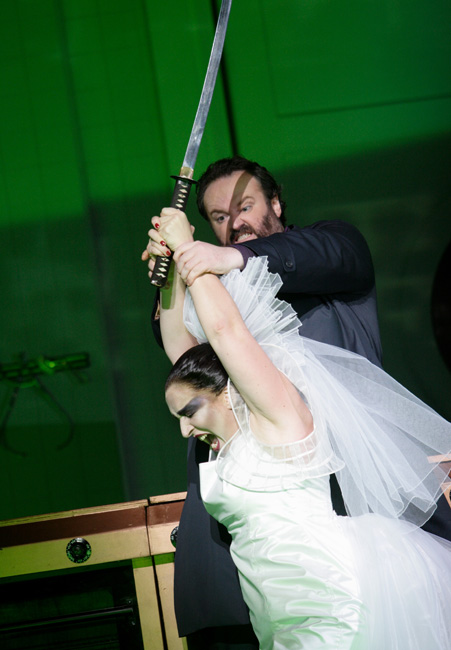Turandot, English National Opera, London Coliseum | reviews, news & interviews
Turandot, English National Opera, London Coliseum
Turandot, English National Opera, London Coliseum
Mamma Mia meets Kill Bill2 in a sharply inventive new production
It’s a let-down when a new production of an opera that spends two acts feeling dazzlingly invigorating and clever collapses in a careless mess in the third. My guess is that a key scene for the concept of English National Opera’s Turandot is when Ping, Pang and Pong - three very grand court officials - turn out to be Chinese cooks sneaking smokes up the fire escape at the Emperor Palace restaurant. It's a sharp idea, generating a sensationally visual production, but that fire escape's got to lead somewhere, and in the end it's nowhere.
The production is a debutants’ ball, with first-time ENO efforts - or fresh thinking, if you like - on direction (Rupert Goold), conducting (Edward Gardner), design (Miriam Buether), and from the Turandot and Liù (Kirsten Blanck and Amanda Echalaz) and Calaf (Gwyn Hughes Jones). It replaces Christopher Alden's anti-romantic 1994 one with what looks like a joint wrap party for Mamma Mia! and Kill Bill.
Given the unstable way that Turandot (1926) trembles on the wire between old-style and modern, it’s unsurprising that the new team plumped for surreal and satirical, an approach that fundamentally suits the music's bipolar swings from romanticism to modernism. The more so when Gardner underpins Goold’s liberal flights of fantasy with conducting of such instinctive light, emotional shading and rhythmic suppleness.
We’re in a very red Chinese restaurant in Peking, full of diners dressed to kill in party gear. There are Elvises, a Janet Street Porter, a nun, a schoolgirl with a badminton racket, an old lady who keeps redoing her lipstick, a rabbi, a clown, a mum in leggings, and so on. You quickly notice what a scary place it is - the customers are kept in check by a team of waitresses with whips, the three chefs flame their woks frighteningly and brandish long blades, while their sous-chefs wear pigs' heads and bloodied aprons, and menace diners with cleavers. Around everybody prowls a floppy-haired bloke in a beige suit scribbling in a notebook, like a writer... or, you spotted it from the start, the alter-ego of Puccini, who died before finishing the opera.
All this peculiar, disorienting, garish variety coheres when the local health and safety inspector (sorry, the Mandarin) ushers in a ferocious outsize ice sculpture of Turandot as warrior queen. Instantly, that desolately lyrical sigh of the chorus of customers for a time before the terror of Turandot’s curse on men releases a premonition of real horror at what she herself might be.
The omens of something truly terrible in Turandot’s realm are effectively underlined by the insane frivolity of the costumes, amid which the sobriety of Calaf, Timur and Liù stand out. When Calaf sings of his desire to challenge Turandot’s riddles, it’s a man poised to step out of the world of sense and life insurance and into the world of fatal illusions and crazy irresponsibility. By the end, when he has watched Liù die by the hand of his chosen love, his transformation into a man of ice is complete.
 It is thoroughly in keeping with this that Turandot is accompanied by a weird and wonderful little corps de ballet of evil girls, costumed as multiple Uma Thurmans in delectable little gold macs and pink bobbed wigs (Katrina Lindsay's scene-stealing designs). Their mechanical routines, smartly choreographed by Aletta Collins, support the image of a woman of power who’s walled herself up inside a fortress of rage, revenge and total obedience. Kirsten Blanck (pictured right with Jones's Calaf) has a proper Turandot voice, firm-tuned, fierce and with the shrill top that suits a character who is a career virgin. It amazes me that she began as a high coloratura. She doesn’t wear the highly stylised white Dragon Bride outfit with much enjoyment, and her English diction is bad (she is German), but she slashes out those big notes as if to draw blood.
It is thoroughly in keeping with this that Turandot is accompanied by a weird and wonderful little corps de ballet of evil girls, costumed as multiple Uma Thurmans in delectable little gold macs and pink bobbed wigs (Katrina Lindsay's scene-stealing designs). Their mechanical routines, smartly choreographed by Aletta Collins, support the image of a woman of power who’s walled herself up inside a fortress of rage, revenge and total obedience. Kirsten Blanck (pictured right with Jones's Calaf) has a proper Turandot voice, firm-tuned, fierce and with the shrill top that suits a character who is a career virgin. It amazes me that she began as a high coloratura. She doesn’t wear the highly stylised white Dragon Bride outfit with much enjoyment, and her English diction is bad (she is German), but she slashes out those big notes as if to draw blood.
The voice of the night, though, is that of the South African Amanda Echalaz, a glorious Liù with luscious Puccinian plangency, though here hampered by a baglady costume. Jones makes a decent fist of the big Calaf vocal moments, but is a dramatic weak link. James Creswell and Stuart Kale impress the diagonal opposition of their roles as the upstanding, blind Timur and the shaky, alcoholic tramp-Emperor. Ping, Pang and Pong's intended trio were critically thrown (and turned into a temporary quartet) by flu.
My problem comes when after two vivid acts in the restaurant’s rooms, we are taken into the clinical kitchen for the final act. By then the gross butchery theme has been well accepted, decapitated princes’ cadavers hanging from the ceiling, but there’s something deeply unatmospheric about Calaf singing “Nessun dorma” while getting himself a drink from the tap. Again, while Liù’s death by torture on the range is probably appealing on the sketchpad - Quentin Tarantino meets Heston Blumenthal - throwing in everything and the kitchen sink is a theatrical distraction from the huge character problems that have built up for Goold to solve, by then some distance from the music.
Further shenanigans with the ever-intrusive writer lead to his gory death taking centre stage, upstaging the climactic love duet of Turandot and Calaf and possibly disguising a total loss of interest in them by the director by then. It is a deflating let-down of imaginative energy when so much went so well for so long.
- In repertory until 12 December. Book online here
- Check out what's on in the ENO season
- Read David Nice's review of Susie Gilbert's ENO chronicle, Opera For Everybody.
Add comment
The future of Arts Journalism
You can stop theartsdesk.com closing!
We urgently need financing to survive. Our fundraising drive has thus far raised £49,000 but we need to reach £100,000 or we will be forced to close. Please contribute here: https://gofund.me/c3f6033d
And if you can forward this information to anyone who might assist, we’d be grateful.

Subscribe to theartsdesk.com
Thank you for continuing to read our work on theartsdesk.com. For unlimited access to every article in its entirety, including our archive of more than 15,000 pieces, we're asking for £5 per month or £40 per year. We feel it's a very good deal, and hope you do too.
To take a subscription now simply click here.
And if you're looking for that extra gift for a friend or family member, why not treat them to a theartsdesk.com gift subscription?

Comments
...
...